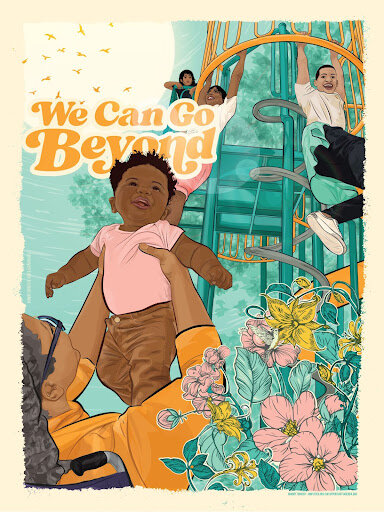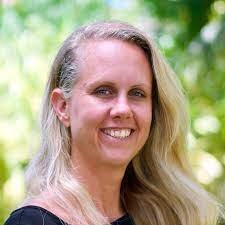By Dr. Amber Strong Makaiau
In times of profound change, the learners inherit the earth, while the learned find themselves beautifully equipped to deal with a world that no longer exists.
--Eric Hoffer, 1982, p. 146
“We Can Go Beyond” by Rommy Torrico, via Amplifier.org
I hope everyone can agree with me that we are indeed in a time of profound change: extreme and visible examples of a divided society, growing climate consciousness, massive income inequality, increased integration of technology into our daily life, resistance to evidence and science-based policy making, new questions about how to organize time and carry out work, protest and progress against racial injustice, voter suppression and increased activism, renewed interest in the arts, the diversification of leadership, and the growing call for more socially just forms of democratic governance. Embedded in this heightened regard for finding new ways to promote a more socially just democratic society is also an expanded interest in social justice education.
In this blog I explore the relationship between modern-day social justice education initiatives and the century-old progressive education movement. I wonder: Are the two enterprises connected? How might we use present-day language to develop our thinking about diversity, equity, and inclusion work in the context of progressive education? And how can we bolster the work of contemporary social justice advocates by building off of the already existing network of progressive education schools and movements? To give thought to these questions, I lean on the philosophers, scholars, and educators who have come before me.
Present-day progressive education proponent, Alfie Kohn provides helpful language for articulating and defining progressive philosophy and pedagogy in the context of today’s world. In the article, Progressive Education: Why It’s Hard to Beat, But Also Hard to Find he describes takeaways from his visits to countless progressive schools, by summarizing that they all reflect a commitment to eight core values. Among these core values is social justice, which he explains as:
A sense of community and responsibility for others isn’t confined to the classroom; indeed, students are helped to locate themselves in widening circles of care that extend beyond self, beyond friends, beyond their own ethnic group, and beyond their own country. Opportunities are offered not only to learn about, but also to put into action, a commitment to diversity and to improving the lives of others.
While reflecting on his definition of social justice education, especially as it relates to the seven other progressive education values on his list, I couldn’t help but notice a common interest in balancing the tension that exists between democracy and education, present action and a better future, and individuals and society.
Democracy and Education
A lot of my own thinking about the relationship between democracy and education has been shaped by the thoughts of the early progressive educators who helped to frame my elementary school experience. About democracy and education, John Dewey (1980) states, “democracy has to be born anew every generation, and education is its midwife” (p. 139). That is, the continuation and evolution of democratic governance is not guaranteed. It is an ongoing human project, which relies on education for the purpose of maintaining and improving upon democratic life. John Dewey’s contemporary, Francis Parker, had similar sentiments and believed that children could only learn how to live in a diverse democracy if they had the opportunity to experience an ideal democracy in schools. He stated, “a school should be a model home, a complete community, and embryonic democracy” (Parker, 2001).
To unpack the project of democracy further, and in relation to current social justice education movements, I turn to Bettina Love. A contemporary scholar and activist who established the Abolitionist Teaching and schools movement, Love (2019) writes:
I do not mean [Democracy] narrowly defined as voting, paying taxes, and knowing how the government works: instead; I am referring to something much deeper...teaching rooted in the internal desire we all have for freedom, joy, restorative justice (restoring humanity, not just rules), and to matter to ourselves, our community, our family, and our country with the profound understanding that we must ‘demand the impossible’ by refusing injustice...(p.7).
And this is where the tension between present action and a better future emerges.
Present Action and A Better Future
Social justice education is based around the principle that we must do the work NOW; we must actively and explicitly address current injustices in schools, if we are to create a better future society. This idea is so eloquently expressed by John Dewey (1916) in Democracy and Education, where he states,
As a society becomes more enlightened, it realizes that it is responsible not to transmit and conserve the whole of its existing achievements, but only such as make for a better future society. The school is its chief agency for the accomplishment of this end (p.20).
However, when moving from the philosophical to the practical--Dewey (2007) also said the following as he reflected on the successes and failures of the Laboratory School at the University of Chicago.
The problem of the relation between individual freedom and collective well-being is today urgent and acute, perhaps more so than at any time in the past. The problem of achieving both of these values without the sacrifice of either one is likely to be the dominant problem of civilization for many years to come. The schools have their part to play in working out the solution, and their own chief task is to create a form of community life and organization in which both of these values are conserved (p. xiii).
Therein lies the tension between individual freedom and the common good that we currently see playing out in our democracy today.
Individuals and Society
How can we honor both individualism and the collective well-being as we work towards creating a better future society? This is where I turn to Paulo Freire and Miles Horton who talk about the importance of creating classroom communities of inquiry where students and teachers engage in a critical or problem-posing approach to teaching and learning. A “critical” or “problem-posing” approach to teaching and learning provides opportunities for students and teachers to “come to see the world not as static reality, but as reality in the process of transformation” (Freire, 1970, p. 84). Through community, dialogue, and inquiry “...liberation is achieved...through an educational practice that itself is both liberatory and participatory, that simultaneously creates a new society and involves the people themselves in the creation of their own knowledge” (Horton & Freire, 1990, p. xxx).
In this approach the classroom community of inquiry is centered around: building meaningful relationships, honoring both the individuals in the room and the group as a whole, keeping an eye on the future while staying in the present, thinking deeply about what matters most, and the social construction of knowledge. As bell hooks (1994) expresses, “we open our minds and hearts so that we can know beyond the boundaries of what is acceptable, so that we can think and rethink, so that we can create new visions...and make education the practice of freedom” (p.12). This is the spirit of social justice in education and the progressive education movement, both of which aim to “develop self-actualizing individuals who can take charge of their own lives and participate fully in the creation of a greater public good” (Bruce & Eryman, 2015, p. 1).
In summary, both progressive educators and modern initiatives in social justice education frame teaching as a political act and they believe that schools have the power to promote a more socially just society through the curriculum, pedagogies, and institutional structures that they develop and maintain. Both movements believe, as teachers, our job is to “not simply to lessen the harshness of social inequities in school, but to change the conditions that create them” (Apple & Beane, 1995, p. 11 - 12). In partnership, the movements can work collectively towards attaining—“full and equal participation of all groups in a society that is mutually shaped to meet their needs…the distribution of resources is equitable and all members are physically and psychologically safe and secure…the process for attaining the goal of social justice…is democratic and participatory, inclusive and affirming of human agency and human capacities for working collaboratively to create change” (Adams, Bell, & Griffin, 2007, p. 1-2). Through equitable relationship building, collaboration, dialogue, co-inquiry, critical analysis, reflection, and informed action against the oppressive social, economic, and cultural power structures that shape our collective lives—students and teachers who carry out a progressive social justice education have the potential to be powerful agents of change. They become beautifully equipped to respond to our rapidly changing world by creating school communities that promote a better future society for today’s children. As Oakes and Lipton (1999) conclude, “being progressive can focus efforts on the process of making the world better and on ensuring that the process is a good one. Hope rests on today’s processes of working to change the world, rather than on the promise of a better world somewhere in the future” (p. 31).
ABOUT THE AUTHOR:
Dr. Amber Strong Makaiau is a Specialist at the University of Hawaiʻi at Mānoa, Director of Curriculum and Research at the Uehiro Academy for Philosophy and Ethics in Education, Director of the Hanahau’oli School Professional Development Center, and Co-Director of the Progressive Philosophy and Pedagogy MEd Interdisciplinary Education, Curriculum Studies program. A former Hawai‘i State Department of Education high school social studies teacher, her work in education is focused around promoting a more just and equitable democracy for today’s children. Dr. Makaiau lives in Honolulu where she enjoys spending time in the ocean with her husband and two children.
Works Cited:
Bruce, C. M., & Eryman, M. Y. (2015). Introduction: The progressive impulse in education. In M. Y. Eryman & B. C. Bruce (Eds.), International handbook of progressive education (pp. 1 - 52). Peter Lang Publishing.
Dewey, J. (2007). Introduction. In K.C. Mayhew & A.C. Edwards. (Eds). The Dewey school: The laboratory school of the university of chicago 1896 - 1903 (pp. xiii - xiv). [Introduction] AldineTransaction.
Dewey, J. (1980). The Middle works, 1899-1924. SIU Press.
Dewey, J. (1916). Democracy and education: An introduction to the philosophy of education. The Free Press.
Freire, P. (1970). Pedagogy of the oppressed. Continuum.
Hoffer, E. (1982). Between the devil and the dragon. The best essays and aphorisms of Eric Hoffer. New York, NY: Harper & Row.
Hooks, b. (1994). Teaching to transgress: Education as the practice of freedom. Routledge.
Horton, M., Bell, B., Gaventa, J., & Peters, J. M. (1990). We make the road by walking: Conversations on education and social change. Philadelphia: Temple University Press.
Oakes, J., & Lipton, M. (1999). Teaching to change the world. Boston: McGraw-Hill.
Parker, F. (2001). Talks on pedagogics: An outline of the theory of concentration and other writings. The Francis W. Parker School.




